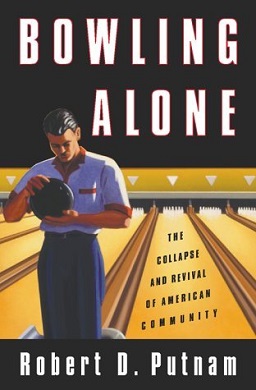
Bowling Alone: The Collapse and Revival of American Community is a 2000 book by Robert D. Putnam. It was developed from his 1995 essay entitled “Bowling Alone: America’s Declining Social Capital“. Putnam surveys the decline of social capital in the United States since 1950. He describes the reduction in all the forms of in-person social interaction upon which Americans used to found, educate, and enrich the fabric of their social lives. He argues that this decline undermines active civil engagement, which a strong democracy requires.
To illustrate why the decline in Americans’ membership in social organizations is problematic to democracy, Putnam uses bowling as an example. Although the number of people who bowl has increased in the last 20 years (1980-2000), the number of people who bowl in leagues has decreased. If people bowl alone, they do not participate in social interaction and civic discussions that might occur in a league environment.
Abstract from 1995 essay:
“The US once had an enviable society, but over the last two or three decades this civic society has shrunk, and more people are watching TV. Possible explanations for this trend include more women in the workplace, increased mobility of families and changing demographics.”
(Full Essay Here)



